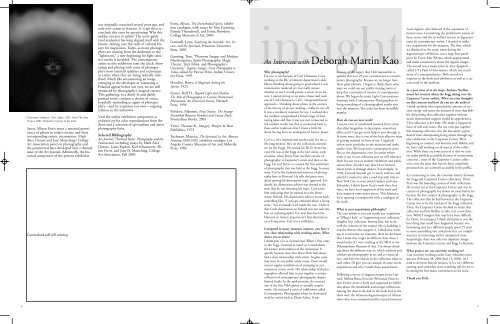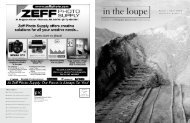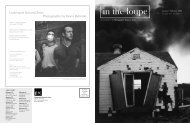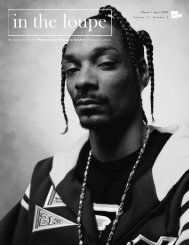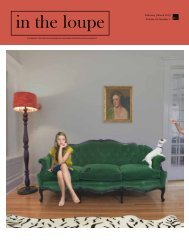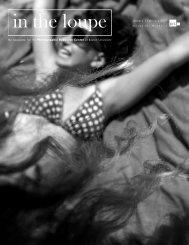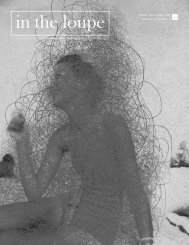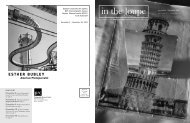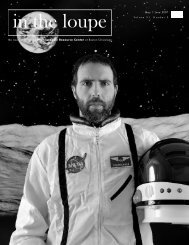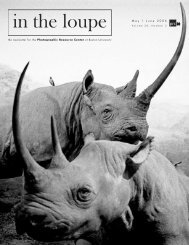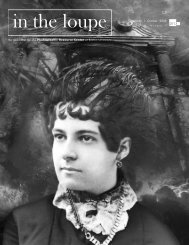Chrysanne Stathacos, Nara, Japan, 2001, from The AuraProject, 2001, Polaroid, Courtesy of the artist.Spirit, Allison Ferris notes a renewed prominenceof ghosts in today’s society and theircorresponding artistic incarnations. MarkAlice Durant and Jane Marsching’s CollegeArt Association panel on photography andthe paranormal later developed into a themedissue of the Art Journal. Admittedly, the historicalcomponent of the present exhibitionCameraland.pdf still missingwas originally conceived several years ago, andonly now comes to fruition. It is apt then toconclude this essay by questioning: Why thissudden interest in spirits? The avant-garde(and academia) has long aligned itself with thebizarre, delving into the vault of cultural historyfor inspiration. Today, as many photographersare moving from the darkroom to the“lightroom,” a new beginning for light sensitivemedia is heralded. The contemporaryartists in this exhibition reset the clock, showcasingand playing with some of photography’smost essential qualities and techniquesat a time when they are being radically redefined.Much like encountering an imageemerging in the developer or witnessing aPolaroid appear before our eyes, we are stillentranced by photography’s magical essence.This gathering, in a dimly lit and darklypainted room, conjures a chorus of voices,hopefully reminding us again of photography’s—andby extension our own—ongoingrelation to the unknown.Visit the online exhibition component atprcboston.org for color reproductions from theshow and a selection of spiritualism and spiritphotography links.Selected BibliographyArt Journal, Themed Issue: <strong>Photography</strong> and theParanormal, including essays by Mark AliceDurant, Louis Kaplan, Karl Schoonover, AlisonFerris, and Jane D. Marsching, CollegeArt Association, Fall 2003Ferris, Alison, The Disembodied Spirit, exhibitioncatalogue, with essays by Tom Gunning,Pamela Thurschwell, and Ferris, BowdoinCollege Museum of Art, 2003Gamwell, Lynn, Exploring the Invisible: Art, Science,and the Spiritual, Princeton UniversityPress, 2002Gunning, Tom, “Phantom Images and ModernManifestations: Spirit <strong>Photography</strong>, MagicTheater, Trick Films, and <strong>Photography</strong>’sUncanny,” Fugitive Images: From <strong>Photography</strong> toVideo, edited by Patrice Petro, Indian UniversityPress, 1995Houdini, Harry, A Magician Among theSpirits, 1924Krauss, Rolf H., Beyond Light and Shadow,The Role of <strong>Photography</strong> in Certain ParanormalPhenomena: An Historical Survey, NazraeliPress, 1994Polidoro, Massimo, Final Séance, The StrangeFriendship Between Houdini and Conan Doyle,Prometheus Books, 2001Tietze, Thomas R., Margery, Harper & RowPublishers, 1973Tuchman, Maurice, The Spiritual in Art: AbstractPainting 1890-1985, exhibition catalogue, LosAngeles County Museum of Art and AbbevillePress, 1986insightAn Interview with Deborah Martin KaoWhy photography?For me, it was because of Carl Chiarenza. I wasworking in the BU art history department’s slidelibrary thinking about going to grad school. I wasinterested in medieval art, but really unsurewhether or not I would pursue a career in art history.I started sitting in on some classes and tookone of Carl Chiarenza’s. Carl’s “integrated history”approach—˜thinking about photo in the contextof the history of picture making—really set me off.It was a revelatory moment for me. I realized thatthe medium encapsulated a broad range of fascinatingideas and that it was not just connected tothe modern world, but that it connected back tothese earlier traditions that I knew a little bitabout having been an undergrad art history major.Carl is a very inspirational teacher and, for me, alife-long mentor. He’s on the collections committee[at the Fogg]. He earned his Ph.D. from Harvard.He was at the Fogg in the late sixties, earlyseventies, when Davis Pratt was first curator ofphotography at Carpenter Center and then at theFogg. He and Davis co-curated the first exhibitionof photography that was held at the Fogg. In manyways, Carl is the institutional memory of photographyhere at Harvard. He tells this great storyabout getting his dissertation topic approved. Evidently,his dissertation advisor was abroad at thetime that he was choosing his topic. Carl wrotehim indicating that he wanted to write aboutAaron Siskind. His dissertation advisor wrote backsomething like, “I can’t get enthused about a livingartist,” but eventually Carl made the case. I believethat Carl’s dissertation on Siskind was not only thefirst on a photographer, but may have been theHarvard art history department’s first dissertationon a living artist. Carl was a trailblazer.Compared to many museum curators, you have avery close relationship with working artists. Whatdraws you to them?I think part of it is institutional. When I first cameto the Fogg, I learned as much as I could aboutthe history and tradition of the institution. Itquickly became clear that Davis Pratt had alwayshad a close relationship with artists. In glass casesthat were in our public study room, Davis wouldmount regular installations of emerging or contemporaryartists’ work. His relationship with photographersallowed him to put together a uniquecollection of contemporary photography despitelimited funds. In the mid-seventies, he receivedone of the first NEA grants to actually acquireworks. He initiated a series of exhibitions calledContemporary Photographs where he showcasedwork by artists such as Diane Arbus. It wasbecause of this legacy that I felt responsible touphold that over 25-year commitment to contemporaryphotography. Because we no longer havethose glass cabinets, I began to think about otherways we could use our public viewing room tokeep that continuity of interest in contemporaryphoto. We began the series Light Conversations:Seminars with Contemporary Photographers tobring something of a choreographed studio visitinto the museum. The series has been incrediblypopular.How do you see new work?I receive a lot of unsolicited material from artiststhat often languishes in skyscrapers around myoffice until I can get some help to sort through it.In some ways, that is one of the least effective waysof getting material in front of me. I regularlyreview artist portfolios in the museum and makestudio visits. We keep active contemporary artistfiles in the department, even for artists whosework is not in our collection and we will referencethem for our own or student exhibition and publicationideas. Another way that I have learnedabout artists is through dealers. For example, in1996, Howard Yezerski got in touch with me andasked if I wanted to take a road trip with him toNew York City to meet John Coplans and GarySchneider. I didn’t know Gary’s work then, butsince, we have been supporters of his work andhave acquired some major pieces. This <strong>February</strong>,we’re opening a retrospective with a catalogue ofhis work.What is your acquisitions philosophy?The easy answer is you can justify any acquisitionas “filling a hole” or “augmenting your collection.”[laughs] Any collection, bottom line, has to dowith the interests of the curator who is building itand the donors who support it. I think that workingin a university art museum, there are decisionsthat I make that might be different than those Iwould make if I were working at the MFA or the[Metropolitan Museum of Art]. I’m always thinkingabout the different ways in which students andscholars use photography as art and as visual culture,and how the objects in the collection relate toeach other. I’ll give you an example of some recentacquisitions and why I made those acquisitions:Following a survey of daguerreotypes across Harvard,Melissa Banta from the Weissman PreservationCenter wrote a book and organized an exhibitionabout the remarkable and unique collections.Among the objects she had in the book and in theshow were the infamous daguerreotypes of Africanslaves that were commissioned by natural historianLouis Agassiz, who believed in the separation ofhuman races. Considering the problematic nature ofthese items, and the revitalized interest in daguerreotypesby contemporary artists, I decided to maketwo acquisitions for the museum. The first, whichwe displayed in the study room during thedaguerreotype exhibition, was a large four-panelpiece by Carrie Mae Weems, which appropriatedand made commentary about the Agassiz images.The second was a major piece by Jerry Spagnolicalled 1/2 a Pack of Firecrackers, which was muchmore of a conceptual piece. Both served as aresponse to the book and exhibition as well as a currenttrend in the medium.In a past issue of in the loupe, Barbara Norfleetnoted her concern about the Fogg taking over theCarpenter Center archive. What are your thoughtson this concern and how do you see the archive?I think anybody who expended the amount of creativeenergy and spent the amount of time that Bobbiedid putting that collection together withoutmuch institutional support would be apprehensive.That collection is her baby. She made it happen byforce of will and vision. She not only put togetherthis amazing collection, but she also spent a greatdeal of time championing living artists through regularexhibitions at the Carpenter Center. We’rebeginning to conduct oral histories with Bobbie andwe have staff working on all aspects of the collection.While there are some parts of it that we can’tyet make publicly accessible because of conservationconcerns, , most of the Carpenter Center’s collection,even the parts that haven’t been completelyprocessed yet, are currently accessible to the public.It is interesting to note the common history betweenthe Fogg and Carpenter Center collections. DavisPratt was the founding curator of both collections.He started out at the Carpenter Center and was itscurator of photography for almost six years before hebecame the first curator of photography at the Fogg.The collection that he had formed at the CarpenterCenter was to be the nucleus of the Fogg collection.Then, the Carpenter Center decided to retain thatcollection and hire Bobbie to take it in a new direction.While I imagine that may have been difficultfor Davis, in retrospect I think ultimately it was thebest thing that could have happened because twofascinating and very different people spent 25 yearsor more assembling two collections that are complimentaryin interesting and in unexpected ways.Surprisingly, there was only one duplicate imagebetween the Carpenter Center and Fogg Collections.What project are you currently working on?I am currently working on the Gary Schneider retrospective(<strong>February</strong> 28, <strong>2004</strong>-June 13, <strong>2004</strong>). As Itend to do more historic projects, it is a very different,exciting, and somewhat nerve-wracking role for me tobe among the first major commenters on his work.Thank you Debi.89
10photography events in new england and beyondEXHIBITIONSMASSACHUSETTSArt Complex Museum at DuxburyPhotoplay: Three Alternative Photographers,Walter Crump, Susan Haas, and Laura Blacklow(thru Jan 11). Wed–Sun, 1–4. 189 Alden St.,Duxbury, MA 02331. 781-934-6634.www.artcomplex.orgBernard Toale GalleryNicholas Nixon: Views; Honeymoon Suite byPenelope Umbrico (Jan 7–Feb 14). Opening receptionJan 10, 5:30–7:30. Tue-Sat, 10:30–5:30. 450Harrison Ave., <strong>Boston</strong>, MA. 617-482-2477.www.bernardtoalegallery.com<strong>Boston</strong> Public Library150th Annual <strong>Boston</strong> Police Department’sPhotographs from the <strong>Boston</strong> Police DepartmentArchives (Feb). 700 Boylston St., <strong>Boston</strong>, MA02116. 617-536-5400. www.bpl.org<strong>Boston</strong> University Art GalleryCalifornia Dreamin’: Camera Clubs and thePictorial <strong>Photography</strong> Tradition (Jan 30–Mar 28).Tue–Fri, 10–5; Sat-Sun, 1-5. 855 CommonwealthAvenue, <strong>Boston</strong>, MA 02215. 617-353-3329.www.bu.edu/artColdwell BankerFirst Exposure, photographs by Annette Stafford(Dec 3–Mar 1). Mon–Fri, 9–7; Sat–Sun, 9–5.1730 Massachusetts Ave., Cambridge, MA 02138.617-864-4430Davis Museum and Cultural Centerat Wellesley CollegePrints from the Permanent Collection in Print StudyCorridor (ongoing). Tue–Sat, 11–5; Sun, 1–5.Wellesley College, 106 Central St., Wellesley, MA02481. 781-283-2051.www.wellesley.edu/DavisMuseum/DeCordova Museum and Sculpture ParkDeCordova collects gifts from Stephen and Sybil Stone,including photography (thru Jan 18). Self-Evidence:Identity in Contemporary Art (Feb 7–May 30)Jo Yarrington: Jirimani (Feb 7–May 30) Tue–Sun,11–5. 51 Sandy Pond Rd., Lincoln, MA 01773.781-259-8355. www.decordova.orgGallery One at New EnglandSchool of <strong>Photography</strong>Workshop Show (Dec 15–Jan 30). Susan Clain(Feb 2–Mar 8) Mon–Fri, 9–5. 537 CommonwealthAve., <strong>Boston</strong>, MA 02210. 617-437-1868.www.nesop.comGriffin Museum of <strong>Photography</strong>Thomas McGovern: Hard Boys and Bad Girls(Nov 6–Jan 16) in Emerging Artist Gallery. 10thJuried Exhibition (Dec 11–Feb 27). Tue–Sun, 12–4.67 Shore Rd., Winchester, MA 01890. 781-729-1158. www.griffinmuseum.orgLee GallerySelections from the Collection (ongoing) Mon–Fri,10–5:30. 9 Mount Vernon St., 2nd Floor,Winchester, MA 01890. 781-729-7445.www.leegallery.comMassachusetts Museum of Contemporary Art(MASS MoCA)Fantastic! featuring Gregory Crewdson (thru Spring<strong>2004</strong>); Alain Bubler: Plug in City (thru Spring<strong>2004</strong>). Mon–Sun, 11–5; closed Tue.87 Marshall St., North Adams, MA 01247.413-664-4481. www.massmoca.orgMead Art Museum at Amherst CollegeCloth Only Wears to Shreds: Textiles and Photographsfrom the Ulli Beier Collection (Feb 5 - May 16).Tue–Sun, 10–4:30; Thu, 10–9. Intersection ofRte. 9 and South Pleasant St., Amherst, MA.413-542-2335. www.amherst.edu/meadMIT Museum Main GalleryKnowing Where to Stand: Photographs by Anne WhistonSpirn (thru Jan 30). Tue–Fri, 10–5; Sat–Sun,12–5. 265 Massachusetts Ave., Cambridge, MA02139. 617-253-4444. web.mit.edu/museumPanopticon GalleryRock ‘n’ Roll Music Photographs by Herb Greene andRon Pownall (thru Jan 30). Mon–Fri, 10–6; Sat,11–5. 435 Moody St., Waltham, MA 02453.781-647-0100. www.panopt.comPeabody Essex MuseumVanished Kingdoms: The Wuslin, Photographs of Tibet,Mongolia, and China 1921-25 (Nov 1–Feb 1).Mon-Sat, 10–5; Sun, 12–5. East India Sq., Salem,MA 01970. 978-745-9500. www.pem.orgPeabody Museum of Archeology and EthnologyPortraits from China, 1923-1946: Photographersand their Subjects (through Mar 15). Mon–Sun,9–5. 11 Divinity Ave., Cambridge, MA 02138.617-496-0099. www.peabody.harvard.eduRobert Klein GallerySebastiao Salgado and Lewis Wickes Hine (<strong>January</strong> 8–<strong>February</strong> 21). Opening reception: Thursday, <strong>January</strong>8, 6–8 p.m..Tue–Fri, 10–5:30; Sat, 11–5. 38Newbury St., <strong>Boston</strong>, MA 02116. 617-267-7997.www.robertkleingallery.comSmith College Museum of ArtIn <strong>Focus</strong>: A Brief History of <strong>Photography</strong>(Jan 16–April 4). Tue–Sat, 10–4; Sun, 12–4.Smith College, Northampton, MA 01063.413-585-2760. www.smith.edu/artmuseumSong of Myself GalleryBrad Fowler, Revolving Exhibition of Black and WhitePhotographs (ongoing). 349 Commercial St.,Provincetown, MA 02657. 508-487-5736.www.songofmyself.comThe Somerville MuseumLost Theaters of Somerville (thru Mar). Thu, 2–7;Fri, 2–5; Sat, 12–5. 1 Westwood Rd., Somerville,MA 02143. 617-666-9810. www.LostTheaters.orgWilliams College Museum of ArtAntoin Sevruguin and the Persian Image(Jan 10–May 2); Mostly <strong>Photography</strong>: Work since1980 from the Permanent Collection (Jan 31–June13); American Dreams: American Art to 1950 (ongoinguntil March 30). Tue–Sat, 10–5, Sun, 1–5. 15Lawrence Hall Dr., Williamstown, MA 02116.413-597-2429. www.williams.edu/WCMAELSEWHERE IN NEW ENGLANDFine Arts Center Galleries at the University ofin the loupe listings deadlinesMarch/April issue:<strong>January</strong> 23, <strong>2004</strong>May/June issue:March 12, <strong>2004</strong>Rhode IslandCarl Chiarenza: Selected Works (Nov 4–Jan 31).Color, Time and Space Photographs by Stephen Lawson(Feb 5–March 7). Tue–Fri, 12–4, 7:30–9:30; Sat,Sun 1–4. 105 Upper College Rd., Suite 1.Kingston, RI 02881. 401-874-2627.www.uri.edu/artgalleriesRadiant Light GalleryBody, Soul and Architecture (Nov 28–Jan 15).Kiss of Fire: The Images of Barbara Nitke(Feb 14–April). Sat 12–7; first Fri, 5–9. 615 CongressSt., Suite 409, Portland, ME 04101.207.252.7258. www.radiantlightgallery.comRISD Museum of ArtInterior Drama: Aaron Siskind’s photographs of the1940’s (Nov 14–Jan 25); The New York School:Aaron Siskind in Context (Nov 7–Jan 25); AaronSiskind; From Chicago to Providence 1951–91(thru Jan 11); Contemporary <strong>Photography</strong> featuringUta Barth, Nan Goldin, Annu PalakuhanathuMatthews, Shimon Attic, and Francesca Woodman.224 Benefit St., Providence, RI 02903.401-454-6500. www.risd.eduSalt Institute for Documentary StudiesStudent Exhibition (Dec 19–Feb 21). Mon–Fri,11:30–4:30. 110 Exchange St., Portland, ME04112. 207-761-0660. www.salt.eduUniversity of Maine Museum of ArtJonathan Bailey: Seeing Bangor (thru Jan 17).Tue–Sat, 9–6; Sun, 11–5. Norumbega Hall, 40Harlow St., Bangor, ME 04401. 207-561-3350.www.umma.umaine.eduYale Center for British ArtTraces of India: <strong>Photography</strong>, Architecture and the Politicsof Representation (thru Jan 11). Tue–Sat, 10–5;Sun, 12–5. 1080 Chapel St., New Haven, CT06520. 203-432-2800. www.yale.edu/ycbaEDUCATIONThe <strong>Boston</strong> Photo Collaborative offers innovativephotography classes for beginner, intermediate,and advanced levels, amateurs and professionals inblack and white, color, digital and alternativeprocesses. In addition to these high quality classes,the Collaborative runs several community-basedyouth and senior programs. Darkroom rental isalso available. For more information, please visitwww.bostonphoto.org or call 617-524-7729. 67Brookside Avenue, Jamaica Plain, MA 02130.The Cape Cod Photo Workshops offers a widevariety of courses on photography. For moreinformation call 508-255-6808. P.O. Box 1619,N. Eastham, MA 02651.Center for <strong>Photography</strong> at Woodstock offers theWoodstock <strong>Photography</strong> Workshops includingvision, landscape, still life, photojournalism, fineprinting, alternative processes, portfolio review,professional development, figure, portrait, editorialand fine art. For more information, pleasevisit www.cpw.org, email info@cpw.org or call at845-679-6337. 59 Tinker Street, Woodstock, NY12498.The Essex Art Center offers classes in all artisticmedia, including photography. For moreinformation, please visit www.essexartcenter.com orcall 978-685-2343. 56 Island Street, Lawrence,MA 01840.Horizons to Go Travel Programs offers classes inall artistic media, including photography. Formore information, please visit www.horizonsart.comor call 413-549-2900. Horizons to Go!,P.O. Box 2206, Amherst, MA 01004.The Maine Photographic Workshops offers a largevariety of photography workshops. The MPW is ayear-round college and learning center for filmmakers,photographers, actors, writers, digital artistsand creative professionals. They offer 250 one-weekworkshops and master classes. Within MPW, RockportCollege came into existence in 1996 and nowoffers an Associate of Arts degree, a Master of FineArts degree and a one-year Professional Certificateprogram. For more information, please visitwww.theworkshops.com or call 1-877-577-7700. 2Central Street, PO Box 200, Rockport, ME 04856.Nubar Alexanian facilitates <strong>Photography</strong> CritiqueGroups for working professionals, teachers, andother serious photographers who wish to expandor rekindle a personal vision and/or take the nextstep in their work. Groups meet once a monthfor 10 months. For more information please contactMillicent Harvey at mhphoto1@comcast.net.Peters Valley Craft Center offers a wide variety of2-5 day workshops in photography. Coursesrange from photographing 2-D and 3-D work;printing cyanotypes, platinums, and palladiums;darkroom alchemy; still life and environmentalportraiture; pinhole photography; self-promotion;and hand-painted B&W photography. For moreinformation and workshop catalogues, please visitwww.pvcrafts.org or call 973-948-5200. 19 KuhnRoad, Layton, NJ 07851.The Santa Fe Workshops is committed to providinga nurturing, positive, challenging, and experientialphotographic and digital environment inwhich image-makers of all skill levels, ages, andnationalities can explore and achieve their potential.The Santa Fe Workshops is a vital, yearroundeducational center. From beginners toworking professional photographers, they becomeimmersed in a supportive environment that nourishestechnical mastery, daring play, and creativeexpression. For more information, please visitwww.santafeworkshops.com or call 505-983-1400.PO Box 9916, Santa Fe, NM 87504.John Sexton Photo Workshops offers a wide varietyof courses on photography. For more information,please visit www.johnsexton.com. 291 LosAgrinemsors, Carmel Valley, CA, 93924.Snow Farm, The New England Craft Programoffers classes in all artistic media, including photography.For more information please visitwww.snowfarm-art.org, or call at 413-268-3101. 5Clary Road, Williamsburg, MA 01096.South Shore Art Center offers classes in all artisticmedia, including photography. For more information,please visit www.ssac.org or call 781-383-2964.119 Ripley Rd., Cohasset, MA 02025.ENTRIES/OPPORTUNITIESThe Cambridge Art Association (Cambridge,MA) announces a call for entries for its NationalPrize Show to be exhibited May 3–June 24, <strong>2004</strong>.The juror will be Bob Fitzpatrick, Director of theMuseum of Contemporary Art, Chicago, IL.Eleven prizes will be awarded including the Bestof Show Award of $2000 and ten other awards.Only slides will be accepted (no videos). Thedeadline for submissions is <strong>January</strong> 23, <strong>2004</strong>. Fora prospectus send a SASE to the Cambridge ArtAssociation, located at 25 Lowell Street, Cambridge,MA 02138, email cambridgeart@cambridgeart.org,or visit www.cambridgeart.org.Nothing can replace the power of a great photograph.THE TENTH JURIED EXHIBITIONSee this year’s winners on exhibitDecember 11 through <strong>February</strong> 27, <strong>2004</strong>.67 Shore Road, Winchester, MA.For details call 781-729-1158 or visit11


